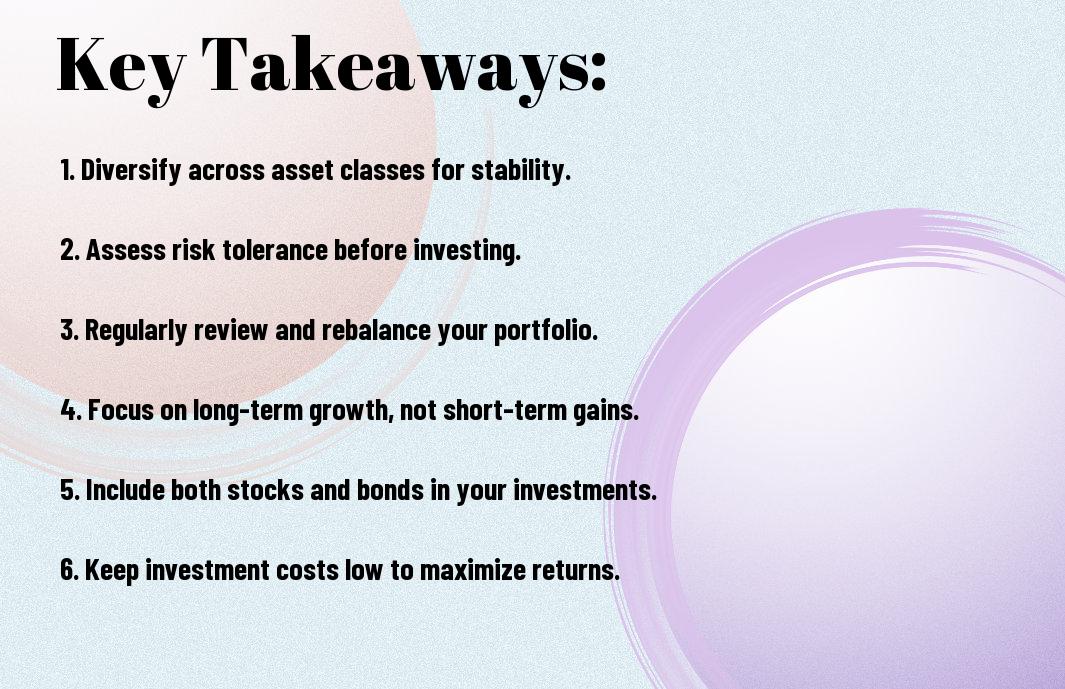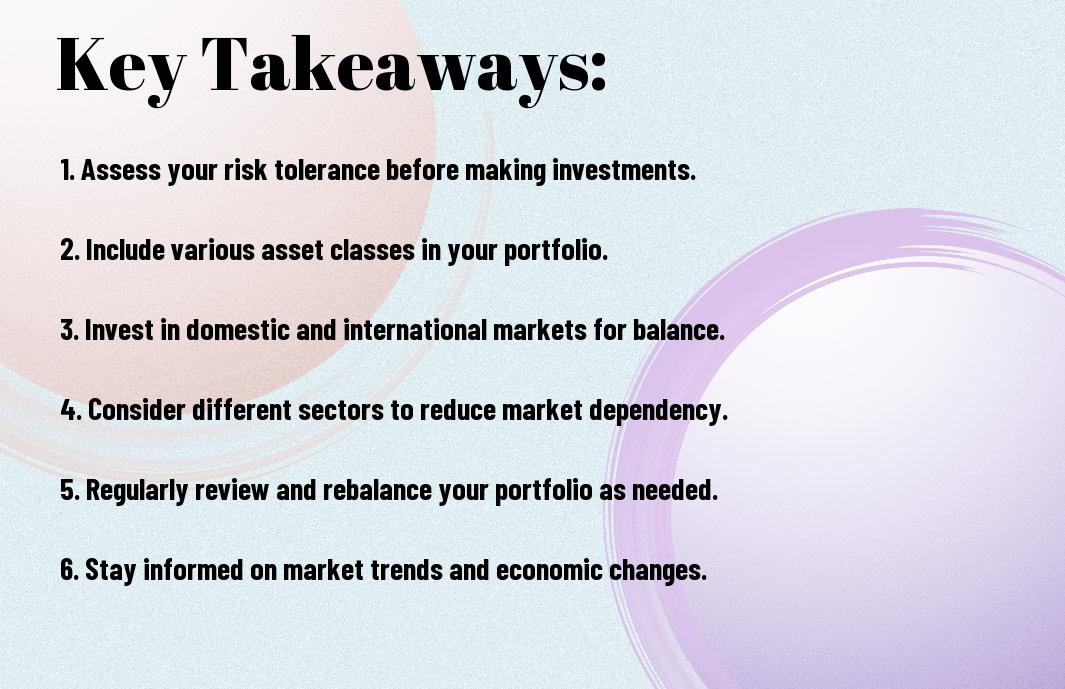Just as a well-balanced diet nourishes your body, a balanced investment portfolio can enhance your financial health. In this guide, you will learn how to allocate your assets effectively across various investment vehicles to optimize returns while minimizing risk. Understanding your risk tolerance, investment goals, and market conditions is key to crafting a strategy that suits your individual needs. For deeper insights, check out this resource on How to Build a Balanced Investment Portfolio.
Key Takeaways:
- Diversification: Spread your investments across different asset classes to reduce risk and increase potential returns.
- Risk Tolerance: Assess your personal risk tolerance to determine the right mix of assets for your financial goals.
- Time Horizon: Align your investment choices with your timeline, as longer horizons may allow for more aggressive investments.
- Regular Review: Periodically review and adjust your portfolio to ensure it meets changing market conditions and personal circumstances.
- Educate Yourself: Stay informed about market trends and investment options to make well-informed decisions.

Understanding Investment Portfolios
For successful investing, you’ll need to grasp the concept of an investment portfolio. An investment portfolio refers to a collection of various financial assets owned by an individual or institution, such as stocks, bonds, and real estate. This aggregation helps you manage risk and create a strategy aimed at achieving your financial goals.
Definition of an Investment Portfolio
Any combination of assets that an investor holds is defined as an investment portfolio. This collection can vary in composition depending on your risk tolerance, investment objectives, and time horizon. By grouping these assets, you can assess their performance and make informed decisions about future investments.
Importance of Diversification
With diversification in your investment portfolio, you spread your assets across various types of investments to mitigate risk. Rather than putting all your funds into a single asset, you create a mix that can potentially protect your overall portfolio from market volatility.
To effectively safeguard your investments, diversification involves not only holding different asset classes—like stocks and bonds—but also investing in various sectors and geographic regions. This approach reduces the impact of any single investment’s poor performance on your overall portfolio. By embracing diversification, you position yourself for more stable returns, helping you achieve your long-term financial objectives.
Assessing Your Risk Tolerance
There’s no one-size-fits-all approach when it comes to investing. Understanding your risk tolerance is crucial in creating a balanced portfolio that aligns with your financial goals. Factors such as your age, financial situation, investment timeline, and emotional resilience all play a role in determining how much risk you can comfortably take on. By honestly evaluating these aspects, you can make informed decisions on how to allocate your investments in a way that suits your lifestyle.
Determining Your Investment Goals
Along with assessing your risk tolerance, clarifying your investment goals is vital for shaping your portfolio. Consider what you aim to achieve—whether it’s saving for retirement, a child’s education, or a major purchase. Each goal may demand a different investment strategy, influencing how aggressive or conservative your allocations should be. By pinpointing these specific objectives, you can align your investment choices with your long-term aspirations.
Risk Assessment Tools
Any serious investor should leverage risk assessment tools to evaluate their investment capacity. These tools help identify your risk appetite through questionnaires, simulations, and scenario analyses. By combining qualitative questions about your comfort with loss and quantitative evaluations of your financial stability, these resources provide valuable insights that guide your investment strategy effectively.
Assessing your risk tolerance using these tools can greatly enhance your understanding of your financial landscape. Many online platforms offer free risk assessment questionnaires that provide insights into your risk profile. Additionally, financial advisors can help interpret the results and develop personalized strategies based on the findings. Utilizing these resources becomes an integral part of crafting a portfolio that aligns with both your financial capacities and your investment goals.
Asset Classes Explained
Unlike fixed income, various asset classes play distinct roles in a balanced investment portfolio. Each asset class, including stocks, bonds, and real estate, carries unique characteristics, risks, and returns. Understanding these differences is crucial for building a diversified strategy that can weather market fluctuations. For insights on How to Create a Worry-Free, Balanced Investment Portfolio, you can explore different options to meet your financial goals.
Stocks
After you invest in stocks, you typically gain ownership stakes in companies, exposing you to potential growth and profits through capital appreciation and dividends. Stocks can offer high returns, but they also come with higher volatility, meaning your investment value can fluctuate significantly over time.
Bonds
The term ‘bonds’ refers to fixed-income securities that investors purchase as loans to corporations or governments, seeking regular interest payments and the return of principal upon maturity. This can provide a more stable income than stocks, appealing to those seeking to reduce risk.
Considering the various types of bonds—such as government, municipal, and corporate bonds—you can tailor your fixed-income investments to match your risk tolerance and income requirements. Bonds can help counterbalance the volatility of stocks, adding stability and preserving capital in your portfolio.
Real Estate and Alternatives
To diversify beyond traditional asset classes, consider investing in real estate and alternative assets, which can include commodities, cryptocurrencies, or private equity. These investments often provide unique opportunities to enhance returns and reduce overall portfolio risk.
Due to their low correlation with stocks and bonds, real estate and alternative investments can act as effective hedges against market downturns. Incorporating these assets into your portfolio allows you to explore additional income streams and potential appreciation, further solidifying your investment strategy.

Building Your Portfolio
Now that you understand the importance of a balanced investment approach, it’s time to build your portfolio. Start by selecting diverse asset classes, including stocks, bonds, and alternative investments. This diversification helps mitigate risk while aiming for growth. Tailor your portfolio to match your financial goals, time horizon, and risk tolerance, ensuring each investment aligns with your overall strategy.
Asset Allocation Strategies
For effective asset allocation, consider a mix of investments that balance risk and return based on your financial objectives. You may use approaches such as the 60/40 rule, where 60% of your assets are in stocks and 40% in bonds, or adjust percentages based on your specific risk appetite. Conducting regular assessments will help align your allocations with market conditions and your evolving goals.
Rebalancing Your Portfolio
About once a year, it’s necessary to review and rebalance your portfolio to maintain your desired asset allocation. As market conditions fluctuate, certain investments may outperform or underperform—this can skew your original strategy, increasing risk or reducing potential gains. By rebalancing, you can ensure that your portfolio remains aligned with your long-term financial objectives.
Consequently, rebalancing helps you lock in profits from top-performing assets while reinvesting in those that may have underperformed. This disciplined approach prevents emotional decision-making and keeps your investments aligned with your risk tolerance. Make it a habit to review your portfolio regularly and make adjustments as needed, ensuring it remains a reflection of your financial goals.
Common Investment Mistakes to Avoid
After you have laid the groundwork for your investment portfolio, it’s necessary to avoid common mistakes that can jeopardize your financial goals. Many investors tend to deviate from their strategies by letting emotions guide their decisions or by becoming too focused on one particular investment. By being aware of these pitfalls, you can make well-informed choices that enhance your investment outcomes.
Emotional Investment Decisions
At times, you may find that your emotions get in the way of logical investment decisions. Whether it’s the fear of losing money or the excitement of a market surge, emotional responses can lead to impulsive actions, such as buying high or selling low. Maintaining a disciplined approach by sticking to your plan can help you navigate these emotional challenges.
Overconcentration in One Asset
Asset allocation is key to a balanced investment strategy, and overconcentration in one asset can lead to significant risks. If you invest too heavily in a single stock or sector, your portfolio’s performance might suffer if that particular asset underperforms. Diversifying your investments across various assets can help spread risk and offer more stable returns over time.
Common scenarios where you may find yourself overconcentrated include investing too much in your employer’s stock or relying solely on one mutual fund. This lack of diversification can expose you to greater volatility and price fluctuations. To prevent overconcentration, regularly review your portfolio and consider reallocating funds to ensure a balanced mix of asset classes, such as stocks, bonds, and alternative investments. This will not only reduce risk but also allow for more consistent growth aligned with your investment goals.
Monitoring and Adjusting Your Portfolio
Your investment portfolio requires ongoing oversight to ensure it aligns with your financial goals and risk tolerance. Regularly monitoring your assets helps identify underperforming investments and opportunities for growth. Adjusting your portfolio when needed empowers you to respond to fluctuations in the market and personal circumstances, leading to better long-term outcomes.
Setting Up Regular Reviews
Reviews should be scheduled at least once or twice a year to assess your portfolio’s performance and to ensure it remains aligned with your financial objectives. During these reviews, consider factors like asset allocation, market trends, and any changes in your personal situation that could affect your investment strategy.
Adapting to Market Changes
The financial markets are dynamic, and your portfolio must reflect the evolving economic landscape. By staying informed about market trends and shifts, you can identify when it’s time to make adjustments to your investments. This proactive approach helps maintain your portfolio’s health and performance in varying market conditions.
Setting up alerts for market indicators and subscribing to relevant financial news can help you stay aware of potential impacts on your investments. You might choose to reallocate funds between asset classes or diversify into new sectors based on emerging trends. The goal is to ensure that your portfolio is resilient enough to weather market downturns while capitalizing on growth opportunities.
Conclusion
As a reminder, creating a balanced investment portfolio involves understanding your financial goals, risk tolerance, and the various asset classes available to you. Diversification is vital, so consider mixing stocks, bonds, and cash equivalents to mitigate risk while pursuing growth. Regularly review and adjust your allocations in response to market changes and life events. For further insights, explore Balanced Investment Strategy: Definition and Examples to guide your investment journey effectively.
FAQ
Q: What is a balanced investment portfolio?
A: A balanced investment portfolio is a diversified collection of different asset classes designed to maximize returns while minimizing risk. Typically, it includes a mix of stocks, bonds, real estate, and cash or cash equivalents. The allocation among these assets is tailored to an investor’s risk tolerance, financial goals, and time horizon, helping to mitigate the impact of market volatility on overall returns.
Q: How do I determine the right asset allocation for my portfolio?
A: Determining the appropriate asset allocation involves assessing several factors, including your financial goals, risk tolerance, and investment time frame. Start by defining your objectives, such as saving for retirement or a major purchase. Next, evaluate your comfort with risk—understanding how much market fluctuations can affect your emotions and financial situation. Finally, consider your investment horizon; usually, longer time frames allow for higher risk tolerance as there is more time to recover from downturns. Based on this information, you can create an asset allocation that aligns with your objectives.
Q: How can I maintain my balanced portfolio over time?
A: Maintaining your balanced portfolio requires regular monitoring and periodic rebalancing. Over time, market changes can shift your asset allocation away from its original design. To keep it balanced, review your portfolio at least annually or after significant market movements. Rebalancing involves adjusting your holdings back to your target allocation, which may include selling assets that have grown to constitute a larger portion of your portfolio and buying more of those that have declined in percentage. Additionally, stay informed on market trends and adjust your strategy if your financial situation or goals change.







